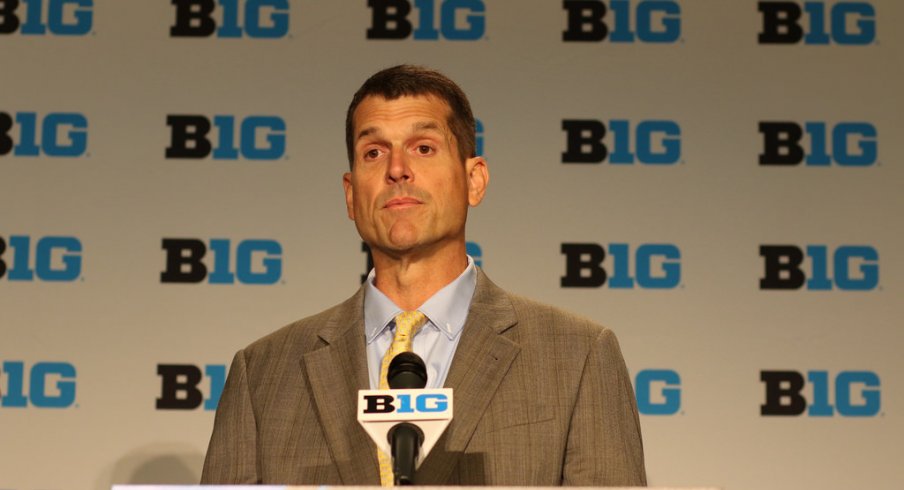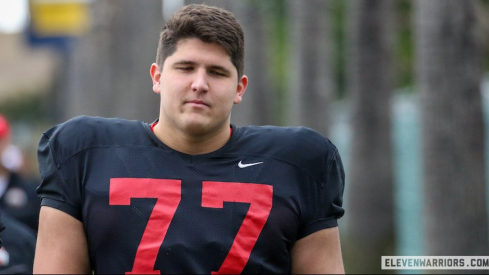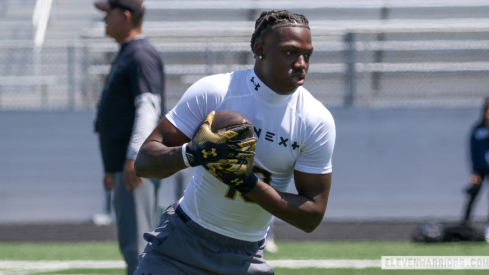Another signing day came and went across the college football landscape, but not without some controversy about major programs not recruiting in “good faith”. I introduce the issue of recruiting in "good faith" below and offer some insights from bargaining scholarship to discuss what recruits can do if coaches are not recruiting in "good faith".
“Good faith” refers to regular contact during negotiations (i.e. “recruitment”) in attempts to reach a mutual agreement during which neither party is negotiating with malice or an intent to defraud the other side. Recruiting in "bad faith" became a source of controversy before signing day.
Riley Cole had been an Alabama verbal pledge since June. Five days before signing day, Alabama’s coaches signaled to Cole that he may have to “grayshirt” his first year on campus. Erik Swenson had been committed to Michigan since November 2013 when Jim Harbaugh’s coaching staff gave him a similar shock two weeks before signing day. Michigan would no longer honor his verbal pledge.
Cole’s family is accusing Alabama’s assistant coaches of a failure to communicate what the new defensive coaching staff had planned for his scholarship status in the fall and whether he would "grayshirt". The “grayshirt” distinction is not trivial either. This amounted to a request that Cole pay his own $26,000 tuition bill his first year on campus with a non-credible promise that Alabama’s program might pick up the tab his second year on campus.
Erik Swenson’s demonstrations were even louder against Michigan’s coaches acting in bad faith. Alabama may have been vague in its signals to Cole about his grayshirt status, but Harbaugh’s staff allegedly sent no signals at all to Swenson that his status in Michigan’s recruiting class was in question.
Recruiting in bad faith carries costs for both the coaching staff and the individual recruit, though my interest here is the recruit’s perspective. Both Cole and Swenson were tasked with finding new colleges on a short turnaround. Swenson at least found another flagship school and college football power at Oklahoma. Cole, given just five days to select a new college, settled for South Alabama.
What can recruits do to avoid some of the major costs associated with a coaching staff recruiting in bad faith?
Keep Working Through the Senior Year
Recruits who commit to programs no later than the summer before the senior year forget that coaches will still evaluate them in the coming fall. Recruits would be wise to make sure the senior year film matches and ideally improves the film that helped earn the major scholarship offers as a sophomore or junior.
There are two rationales that underpin this advice. One, coaches should be upfront that they expect this. Scholarship offers are projections about future potential and not statements about a recent camp performance or a junior year film. A committed prospect that is not taking initiative to improve as a senior sends a bad signal to the coaching staff about the prospect’s future potential. The coaching staff may interpret this as the recruit himself not acting in good faith.
Two, an improved senior year film is insurance for a prospect who finds himself in a position similar to Riley Cole or Erik Swenson.
A recruit with a great senior year film and who is a long-time commit to another program may attract renewed interest, or even a new offer, from a program interested in “flipping” the prospect. This raises some intrigue for recruiting outlets to discuss, but don’t mistake that it’s at least some kind of leverage in the form of a fallback option. It’s a situation that benefits the recruit.
The recruit also helps himself in the event a program to which he is committed is recruiting in bad faith. Erik Swenson was still a consensus four-star tackle and finished his senior season as an All-USA Second Team offensive tackle. This allowed him to draw immediate interest from Oklahoma’s coaches (among others) when Michigan allegedly removed him from its 2016 recruiting class.
Commit Later than Sooner
Recruiting has become an expansive multi-year cycle now that seventh-graders and eighth-graders are receiving college scholarship offers. Prospects are also committing earlier to their favorite colleges. Some prospects are happy to be done with a stressful process and focus instead on a junior or senior season. Sometimes the "dream school" offers and it's too much to not accept immediately.
Recent events and even basic insight from the bargaining literature suggest this not optimal. The recruit who commits early may avoid some “costly delays” of wasting time on an offer already made, but there are other costs as well.
Prospects who commit early to their “dream school” are less likely to receive additional scholarships on which to fall back in the event of the unforeseen. Coaches of other programs are disinclined to pursue recruits committed elsewhere since it’s unlikely to be an effective use of their time. These coaches are interested in available prospects they could attract and sign to their program instead.
Room becomes scarce under these conditions, as Erik Swenson discovered with Wisconsin. Swenson, a prospect from the Chicago area, wanted to play in the Big Ten. Michigan was understandably a dream school under these conditions. Wisconsin expressed a strong interest in Swenson once he decommitted from Michigan, but Wisconsin had no room left in its class for him.
Paul Chryst’s staff was at least forthright with this space limitation when it offered Swenson a grayshirt opportunity. However, paying out-of-state tuition for a year is less than ideal.
This logic partially informs why Ted Ginn Sr. cultivated a practice of having his Tarblooders make their college decisions much later into the process. Observers remarked this practice helped raise awareness for a senior Tarblooder’s teammates who were underclassmen, but there’s more to it. Recruits who hold out and have multiple competing offers induce college coaches to be more forthcoming about where the prospect stands vis-a-vis the program’s recruiting class.
It forces coaches to recruit in good faith or not recruit the prospect at all.
Take Visits, but Stay in Contact with the Recruiter
Recruits who have made their informed college choices early into the cycle should still take visits in various forms. They should also let their primary recruiter for their college choice know about these visits.
There are multiple reasons why prospects should engage in a process that looks like “playing the field” to a casual observer.
One, the recruit will never get another opportunity to have colleges subsidize trips to their campuses with a pledge to also pay for the college education. The NCAA allows five official visits. The prospect may want to consider using them.
Coaches for other programs are more likely to recruit committed prospects if they are taking visits elsewhere. It’s a noisy signal to other coaches that the prospect could be swayed to another program even if the prospect privately knows he does not want to decommit.
Consider it a form of leverage or insurance in the event of the unforeseen mentioned in the previous sections.
Committed prospects who are not entertaining the idea of decommitting should still consider this. Even a camp visit to another school is a signal to the host that the prospect is interested in their program and a signal to the program to which he is committed that the prospect is taking strides to improve his craft under the watchful eye of other college coaches.
Different programs vary on where they stand on this, but coaches appear to be more permissive about prospects taking these visits than they were previously. Let the primary recruiter or player personnel director know ahead of time and there should be no major issue.
Talk Weekly or Move On
Committed recruits owe it to their primary recruiter to inform them of upcoming visits and assuage them about the nature of that visit.
This should be part of weekly communication between a coach and a committed prospect.
The “weekly” qualifier is important. Our experience covering recruiting suggests that coaches who stop weekly communication with a prospect are no longer interested in recruiting him.
This happened to Erik Swenson. He reported there was a month between his last communication with Michigan offensive coordinator Tim Drevno before Drevno informed him to take visits elsewhere.
A recruit who finds more than a week separating last correspondence with a coach should start considering other options before its too late.
Never Commit for the Assistant Coach
Stan Drayton’s departure to the Chicago Bears last year sparked a controversy regarding Mike Weber’s contentious recruiting battle between Ohio State and Michigan. Michigan fans alleged that Urban Meyer was recruiting in bad faith if he knew in advance that Drayton could be taking another job soon.
An informed bargaining perspective suggests that the Michigan fan’s reaction was silly. Of course Urban Meyer would withhold this information if he privately knew it was happening. Head coaches have no choice but to recruit in “bad faith” with prospects on these personnel issues. The assistant coaches do as well.
This seems unfair to recruits for coaches to withhold this information. Recruits clearly bond with their potential position coach on the recruiting trail and would like to play for him. Fans see how unfair this is for recruits but don’t see that it’s also unfair for the assistant coach in question to have an internal issue of retention become public knowledge.
Assistant coaches in cases like Stan Drayton are bargaining over a raise when they leverage an outside job offer (like the NFL) over the current employer. The current employer’s retention offer, should it make one, is used as leverage for a counteroffer. This is how raises and career advancement happen in fields like college football.
If the head coach confesses to the prospect that an assistant coach is likely on the move, he weakens the bargaining leverage for the assistant on both sides. It signals to the assistant that the current employer is unwilling to provide a better retention offer and makes it less likely the new prospective employer sweetens its deal. Head coaches owe honesty to their recruits, but they also owe it to their assistants to not make issues of retention public knowledge. This is true even if it makes for bad public relations in a case like Mike Weber last year.
Recruits can do nothing about this situation. Head coaches and assistant coaches have every incentive to misrepresent their commitment to the current employer for internal issues of compensation.
The most a recruit can do is discount an assistant coach’s pledge to be in the program for the duration of the recruit’s college career. It’s a non-credible promise.
Commit to the program for the academics. Commit for a depth chart opening. Commit for the social life. Never commit to a school for the assistant coach.


